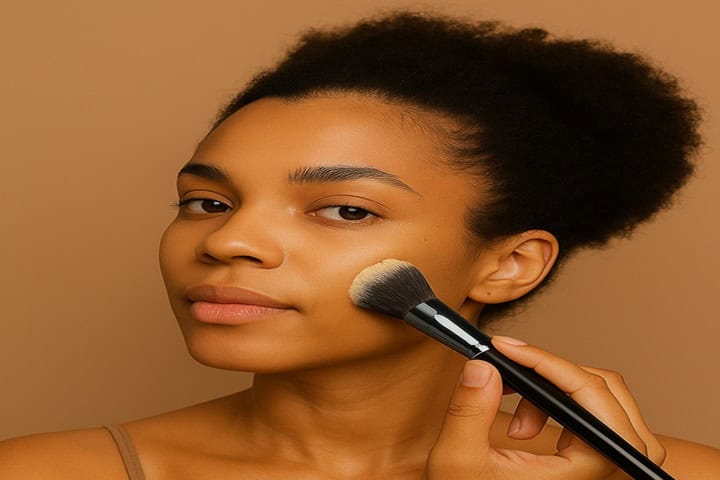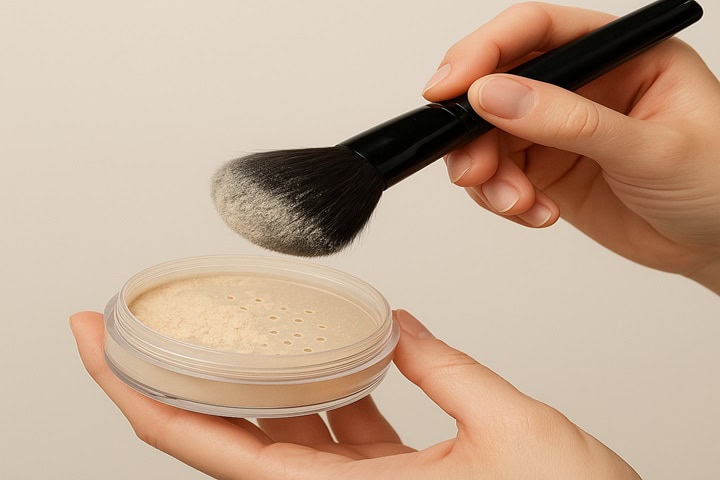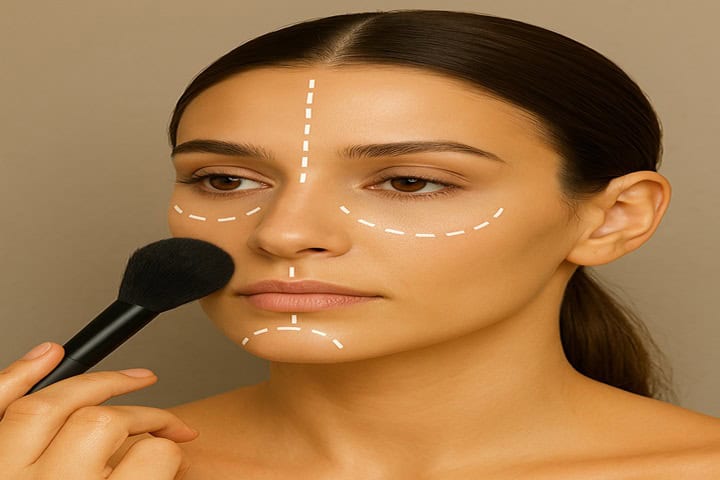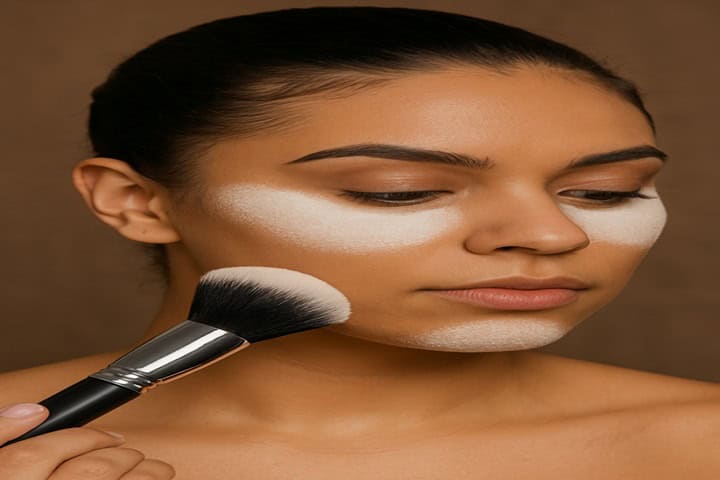How To Use Setting Powder: Professional Guide Makeup Tips
1st June, 2025
A streaky base. A shiny T-zone. Makeup that melts even after lunchtime. If any of that sounds familiar, setting powder might just be the step you’re missing.
Setting powder is an essential tool to have in your professional makeup bag to ensure your skin is properly primed and that the makeup adheres to your face for a longer period. But how do you use setting powder? In this article, you will learn how to use setting powder, from what it does to where and when to apply it for best results. We’ll break down the difference between loose and pressed powder, look at which types suit different skin tones and textures, and guide you through step-by-step application tips that work—whether you’re on or off stage.
Key Points:
- Understand what setting powder is and how it works.
- Learn where to put setting powder for a long-lasting finish.
- Discover when to use setting powder for different makeup looks.
- Compare loose vs. pressed powders and their uses.
- Follow simple, expert-backed steps for applying setting powder properly.
What Is Setting Powder?
Setting powder is a type of makeup powder used to “set” your foundation and concealer. It helps your base makeup stay in place for longer and stops it from creasing or becoming shiny throughout the day. If you’ve ever wondered how to use setting powder, it all comes down to applying it after your liquid or cream products to lock them in.
The fine particles in setting powder soak up any leftover oil or moisture, helping your makeup last longer—especially under hot lights, on camera, or throughout a busy day. While it’s often the final step in a makeup routine, knowing when to use setting powder and how to apply it properly can make all the difference to how your makeup looks and feels.
Types of Setting Powder
There are two main types of setting powder: loose powder and pressed (or compact) powder. Each has its own benefits depending on the finish you’re after and your skin type.
Loose Powder
Loose setting powder is lightweight, finely milled, and comes in small jars or tubs. It’s usually applied with a fluffy brush or puff. Loose powder is popular for setting foundation and concealer because it creates a smooth, matte finish and is ideal for techniques like baking.
There are different types of loose powders to suit different needs:
- Translucent powder: A colourless powder that works on most skin tones. It sets makeup without changing its colour, helps reduce shine, and blurs fine lines.
- Banana powder: This yellow-toned powder is great for brightening under the eyes and cancelling out redness or dark tones. It’s often used on medium to deep skin tones but can also work as a subtle highlight for lighter complexions.
- Tinted powder: Comes in various shades to match skin tone. It’s perfect if you want your setting powder to offer a touch of coverage, or blend in seamlessly without any white cast.
- Dewy finish powder: Contains light-reflecting particles that add a soft glow—ideal for dry or dull skin types.
Loose powders are perfect if you want a more flexible and breathable finish, or if you’re working on full glam or stage makeup looks.
Pressed Powder
Pressed powder is compacted into a solid form and usually comes in a mirrored case. It’s easier to carry around and is less messy to use. While not as finely milled as loose powders, it’s great for quick touch-ups during the day or evening.
Pressed powder is often used for:
- Quick fixes on the go
- Blotting oil from the T-zone
- Adding coverage in certain areas
- A soft matte finish without a heavy look
Both types are useful—you just need to pick the right one for your needs. If you’re wondering where to put setting powder, it’s typically applied to oily zones like the forehead, nose, and chin, but you can also dust it lightly across the whole face for full coverage.
When Should You Use Setting Powder?
Knowing when to use setting powder depends on your makeup routine and your skin type. You’ll usually apply it after foundation and concealer, but you can also use it on bare skin to reduce shine or even out texture.
Use it when:
- Your makeup needs to last all day or night
- You want to reduce oil or shine
- You need your base to stay put under lights or heat
- You’re baking under the eyes or sculpting the face
Setting powder doesn’t have to be heavy or cakey—with the right product and technique, it can help you get a smooth, long-lasting finish every time.
Want a reliable translucent powder trusted by pros? Try the Mehron Colorset Powder —a go-to choice for makeup that needs to stay put in heat, humidity, or under harsh lights.
How to Use Setting Powder: Step-by-Step
Learning how to use setting powder properly makes a big difference in how long your makeup lasts—and how smooth it looks in person and on camera. Whether you’re using loose or pressed powder, the method of application can change the final result. Here’s how to apply it the right way from start to finish.
Step 1: Prep Your Skin

Before reaching for any powder, it’s important to start with clean, hydrated skin. Primer or moisturiser first? Use a gentle cleanser that suits your skin type and follow with a lightweight moisturiser.
Give the moisturiser a few minutes to settle so it doesn’t interfere with your base products. If you’re heading out in the day, a moisturiser with SPF is always a good idea.
Step 2: Apply Your Base Makeup

Now that your skin is prepped, apply a primer to create a smooth canvas. Follow this with your chosen foundation and concealer.
Blend everything well and wait a minute before applying powder—this allows your base to slightly set on its own, making the next step more effective.
Step 3: Dispense and Load the Powder

If you’re using loose powder, tap a small amount into the lid or onto a clean makeup tray. Swirl your brush or puff into the powder and tap off the excess. This gives you better control over how much you’re applying.
With pressed powder, swirl your brush directly on the compact to pick up product evenly.
Step 4: Where to Put Setting Powder

Knowing where to put setting powder is just as important as how to apply it. Focus on areas that tend to get oily or where makeup creases:
- T-zone (forehead, nose, chin)
- Under the eyes
- Around the mouth
- Any areas that need a longer hold
Using a fluffy brush, lightly press and swirl the powder onto these areas. For under the eyes or more precise areas, use a smaller brush or a sponge to press the powder in. Don’t rub—it can move your foundation around.
Step 5: Let It Set or Bake

You can use a light hand for a natural finish, or let the powder sit (or “bake”) on the skin for a few minutes, especially under the eyes or jawline. After a few minutes, gently dust off any excess powder with a clean brush. This gives a smoother, more matte effect.
Step 6: Add More If Needed
If you still see shine or want a more matte finish, apply a second light layer. The key is to build slowly—too much powder at once can make your makeup look heavy or patchy.
When to Use Setting Powder
A common question is when to use setting powder. The most common time is after applying foundation and concealer, but there are other times it can help:
- Over bare skin to reduce oil or shine
- Before applying eye makeup to stop fallout from sticking
- Midday touch-ups to reduce shine without layering more foundation
- On top of cream blush or contour to lock in shape and colour
You don’t have to wait for special occasions to use it—it works just as well for everyday looks.
Tips for Better Results
Here are a few quick tips that will help you make the most of your powder:
- Less is more: Start small and build up only if you need to.
- Hydrate well: Dry skin and powder don’t mix unless you moisturise first.
- Try different tools: A brush gives a soft look, while a puff presses powder in for longer wear.
- Choose the right powder: Translucent for all skin tones, tinted to match your shade, or banana for brightening.
Pressed vs Loose Setting Powder
Still deciding which one to use? Here’s a quick breakdown:
| Feature | Loose Powder | Pressed Powder |
| Texture | Fine, loose weight | Denser, more compact |
| Finish | Smooth, soft focus | Natural to Matte |
| Best For | Full makeup routine, baking | Touch-up, travel, quick focus |
| Application | Brush, puff, sponge | Brush or powder puff |
| Portability | Less convenient (spill easily) | Easy to use and on the go |
Both work well—it really depends on your routine and preferences.
Looking for high-performance powders for film, theatre, or cosplay? Browse our full range of SFX setting powders
Apply Setting Powder In Your Makeup Routine
In conclusion, setting powder can make all the difference when it comes to keeping your makeup in place and looking smooth. Whether you prefer loose or pressed powder, knowing how to use setting powder properly—and when and where to apply it—can help you avoid shine, creasing, and smudging. From prepping your skin to locking in your base, the right techniques give you longer wear and a more polished finish, whether it’s for stage, screen, or everyday wear.
Setting powder isn’t one-size-fits-all—especially for mature skin. If you’re looking for options that work well with fine lines or drier textures, check out this expert round-up of the best setting powders for mature skin
Further reading:
Like what you read? Try these further articles to elevate your setting powder in other activities –
FAQs
Can setting powder be used on dry skin?
How much setting powder should I use?
Sources
Rivas, G., (2025) The 9 Best Setting Powders for Mature Skin, According to Makeup Artists. Oprah Daily. [online] Available at: https://www.oprahdaily.com/beauty/g64551303/setting-powder-for-mature-skin/ [accessed 13/05/2025]
Hey there! I’m Isabelle Kerrington, and I’m thrilled to share my passion for the performing arts through my blog. Focusing on theatre makeup, my posts will cover everything from product recommendations to helpful tips and engaging tutorials. Join me on this exciting journey as we explore the magical world of theatre makeup together.
Leave a Reply